You’re probably tired of rushing home to feed your cat or worrying whether they’ve eaten while you’re away. Modern microcontroller technology has transformed pet care, offering sophisticated solutions that go far beyond simple timer-based feeders. These ten innovative approaches combine sensors, connectivity, and smart algorithms to create feeding systems that adapt to your cat’s specific needs, monitor their health, and provide complete control from anywhere. But which solution fits your lifestyle?
Arduino-Based Automatic Pet Feeder With Programmable Timing
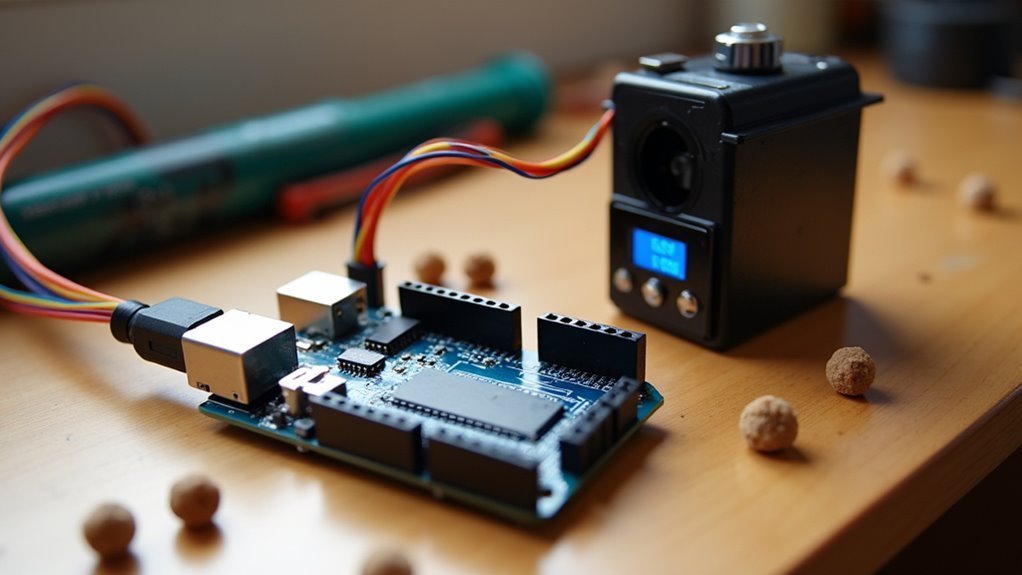
When you’re looking for a reliable solution to maintain consistent feeding schedules for your pets, an Arduino-based automatic feeder offers programmable timing capabilities that eliminate the guesswork from pet care.
This automatic pet feeder lets you program specific feeding times and quantities, ensuring your cat receives consistent meals throughout the day.
The system features a battery-backed real-time clock that maintains accurate timekeeping even during power outages, guaranteeing your pet won’t miss meals.
Battery backup ensures your pet’s feeding schedule remains uninterrupted, even when the power goes out unexpectedly.
You’ll interact with the device through a rotary encoder that enables easy adjustments to feeding times and portions using simple increments and decrements.
An LCD display provides clear visual feedback showing current time, programmed feeding times, and settings.
The code includes both automatic scheduling and manual feeding options, letting you dispense food anytime through push button activation.
RFID-Controlled Feeding System for Multi-Pet Households
In multi-pet households where feeding competition creates chaos, RFID-controlled feeding systems solve this challenge by using unique collar tags that identify each pet individually. You’ll find these pet feeders eliminate food theft while ensuring each animal receives appropriate portion sizes based on their dietary requirements.
| Feature | Benefit |
|---|---|
| Unique collar tags | Prevents food theft between pets |
| Programmable scheduling | Customized feeding times per pet |
| Portion control | Manages individual dietary needs |
The Lesotc RFID Automatic Cat Feeder exemplifies this technology, restricting access for certain pets while allowing others to eat freely. You’ll notice improved eating habits as competition decreases, creating a relaxed environment. Training’s straightforward—gradually introduce the feeder and use treats to familiarize pets with the system for smooth acceptance.
Iot-Enabled Smart Feeder With Mobile App Control

While traditional feeders require you to be physically present, IoT-enabled smart feeders revolutionize pet care by putting complete control in your smartphone.
You’ll schedule feeding times and customize portion sizes remotely through intuitive mobile app control, ensuring your cat maintains consistent meal schedules even when you’re away.
Weight sensors and cameras monitor food levels while detecting your pet’s presence, guaranteeing accurate feeding.
Smart sensors and cameras work together to precisely track food inventory and confirm your pet’s feeding activity for foolproof meal delivery.
Cloud connectivity syncs your schedules across devices and delivers real-time updates.
The user-friendly interface lets you create custom meal plans, track your cat’s weight, and receive low-food alerts instantly.
Advanced models incorporate machine learning to analyze your cat’s eating patterns, automatically optimizing portions for healthier habits.
This intelligent system adapts to your pet’s specific needs over time.
Weight Sensor Integration for Portion Control Management
You’ll need to integrate an HX711 weight sensor into your automatic cat feeding system to attain accurate portion control management.
This sensor connects directly to your microcontroller and provides real-time weight measurements of both the food container and dispensed portions.
Setting up the HX711 properly guarantees you can monitor food levels continuously and deliver precise meal portions based on your cat’s dietary requirements.
HX711 Sensor Setup
Accurate portion control forms the foundation of any effective automatic cat feeding system, and the HX711 sensor delivers the precision you need to monitor food dispensing with remarkable accuracy.
This 24-bit ADC sensor provides high-resolution measurements that precisely track the amount of food dispensed to your feline companion.
Setting up your HX711 sensor requires these essential steps:
- Connect the sensor to your Arduino using only two communication pins for simplified wiring.
- Calibrate the system by comparing sensor readings against known weight values to establish precise scale factors.
- Configure load cell compatibility to match your specific feeding system requirements.
- Test measurement accuracy with various food portions to guarantee consistent performance.
The HX711’s versatility accommodates different load cells, making it adaptable for various feeding configurations and food types.
Precise Portion Measurement
With your HX711 sensor properly configured, weight sensor integration transforms your feeding system into a precision instrument that monitors every gram of food dispensed.
Your weight sensor continuously tracks the food container’s weight, providing real-time feedback that enables precise portion control based on your pet’s specific dietary requirements.
The microcontroller processes weight data to control servo or stepper motor operations, ensuring exact food dispensing at each feeding time.
You’ll eliminate overfeeding and underfeeding risks through accurate measurements that adjust motor timing automatically.
The load cell differentiates between empty and full container states, triggering refill notifications when necessary.
This integration promotes better pet health management by delivering customized portions based on weight measurements, creating a reliable feeding routine that supports ideal nutrition for your cat’s wellbeing.
Stepper Motor Upgrades for Precise Food Dispensing
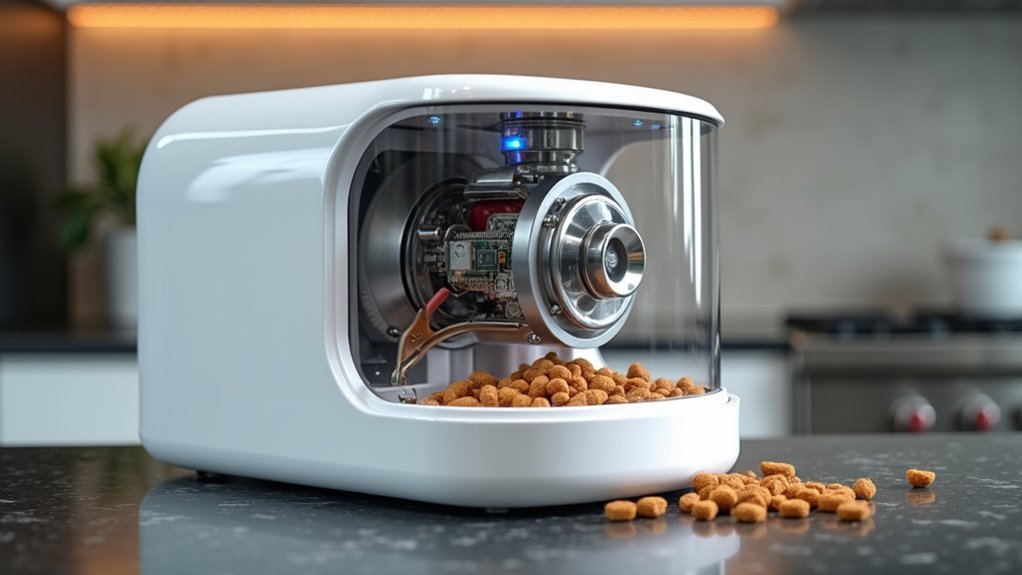
While traditional servo motors can handle basic feeding tasks, upgrading to a NEMA 17 stepper motor transforms your automatic cat feeder into a precision dispensing system. The stepper motor delivers unmatched accuracy for portion control, allowing you to adjust serving sizes based on your cat’s specific dietary needs.
To achieve peak performance in your food dispenser, you’ll need these essential components:
- Easydriver stepper driver – Enables microstepping for smoother, more precise movements
- Proper wiring setup – Connect Step and Dir pins to your Arduino for efficient motor control
- Enable pin configuration – Reduces power consumption by shutting down the motor during idle periods
- Accelstepper library integration – Simplifies coding while providing acceleration and deceleration functions for reliable operation
Ultrasonic Sensors for Proximity Detection and Safety
Beyond precise motor control, your automatic cat feeding system needs intelligent detection capabilities to confirm safe and timely meal delivery.
Ultrasonic sensors provide the perfect solution for proximity detection, using high-frequency sound waves to measure distance accurately. The popular HC-SR04 sensor offers a 2-400 cm range with 3mm precision, making it ideal for detecting when your cat approaches the feeding station.
High-frequency sound waves enable precise distance measurement, making ultrasonic sensors perfect for detecting your cat’s approach to the feeding station.
These non-contact devices eliminate mechanical wear while preventing food wastage. By calculating the time for sound wave echoes to return, your microcontroller can determine exactly when to dispense food.
This proximity-based activation confirms meals are delivered only when your pet is present, preventing overfeeding and maintaining ideal feeding schedules while enhancing overall system safety.
Camera Module Implementation for Pet Recognition
Camera modules transform your automatic feeding system from simple proximity detection to intelligent pet recognition. You’ll achieve precise food dispensing by ensuring only your intended pet receives meals, eliminating feeding mix-ups in multi-pet households.
Your camera module works with YOLOv5 processing to identify pets through visual features, distinguishing between different breeds with remarkable accuracy. The system learns from extensive datasets like Stanford Dogs Dataset, containing over 20,000 images across 120 breeds.
Key camera module benefits include:
- Real-time pet recognition preventing unauthorized feeding access
- Integration with ultrasonic sensors for coordinated proximity detection
- Adaptive learning capabilities improving identification over time
- Customized portion control based on specific pet recognition data
You’ll prevent overfeeding and underfeeding through intelligent visual identification that tailors food dispensing to each recognized pet’s requirements.
Real-Time Clock Systems for Scheduled Feeding
You’ll need to integrate an RTC chip like the DS3231 into your automatic cat feeding system to maintain precise timekeeping for scheduled meals.
The RTC chip connects directly to your microcontroller and constantly monitors the current time against your programmed feeding schedule.
You must also implement a battery backup solution to guarantee the clock continues running during power outages, preventing disrupted feeding times.
RTC Chip Integration
When designing an automatic cat feeding system, integrating an RTC (Real-Time Clock) chip serves as the critical foundation for reliable, scheduled meal delivery. The RTC chip maintains precise timekeeping even during power outages through battery backup, ensuring your cat’s feeding routine remains uninterrupted.
Key benefits of RTC chip integration include:
- High precision timing – Chips like the DS3231 offer ±2 minutes per year accuracy
- Programmable schedules – Enable up to two daily feeding times for ideal convenience
- I2C communication – Seamless interface with Arduino microcontrollers for easy implementation
- Power efficiency – Interrupt service routines monitor scheduled times while maintaining low power consumption
You’ll find that proper RTC chip integration transforms your feeding system into a dependable, automated solution that consistently delivers meals according to your predetermined schedule.
Battery Backup Solutions
Battery backup systems form the backbone of uninterrupted feeding schedules, safeguarding your cat’s routine against unexpected power failures.
You’ll want to integrate a coin cell battery with your RTC module to maintain accurate timekeeping when the main power supply disconnects. This battery backup guarantees your DS3231 continues tracking time independently, preserving scheduled feeding times even during extended outages.
Your ESP8266 can synchronize with internet time servers, updating the RTC for maximum accuracy.
Store feeding schedules in EEPROM to retain configurations after power loss. Consider using efficient power management techniques to extend battery life.
A well-designed battery backup system assures your automatic feeder operates reliably, maintaining your pet’s feeding routine regardless of power disruptions while minimizing overall power consumption.
Servo Motor Mechanisms for Auger-Based Food Delivery
Since precise food delivery defines the core functionality of automatic feeding systems, servo motors stand as the driving force behind reliable auger-based mechanisms.
You’ll find continuous rotation servos particularly effective for controlling auger dispensing systems because they provide infinite rotation essential for consistent food delivery.
When implementing your servo motor mechanism, consider these key components:
- 3D printed auger attachments that secure directly onto your servo shaft for stable operation
- Speed and direction control through programming to customize portion sizes based on your cat’s needs
- Rotary encoder integration for real-time feedback on dispensed amounts
- Continuous rotation modification enabling unlimited movement for extended feeding cycles
This combination guarantees your auger transports food smoothly from hopper to bowl while maintaining accurate portion control through precise servo programming.
Deep Learning Integration for Breed-Specific Nutrition
While traditional feeding systems operate on basic timer mechanisms, deep learning integration transforms your automatic cat feeder into an intelligent nutrition management system that recognizes specific breeds and adapts feeding protocols accordingly.
You’ll leverage advanced models like YOLOv5 for real-time breed identification, processing images with remarkable speed and accuracy. The system draws from extensive datasets containing thousands of breed images, enabling precise classification that prevents misfeeding incidents.
Your deep learning-enabled cat feeder analyzes each pet’s unique characteristics, automatically adjusting portion sizes and nutritional compositions based on breed-specific requirements.
This technology eliminates guesswork in pet nutrition management, creating customized feeding schedules that promote ideal health. Through sophisticated image processing techniques, you’ll minimize identification errors while ensuring your cats receive appropriate nutrition tailored to their specific breed needs.
Frequently Asked Questions
How Many Days Can You Leave a Cat With an Automatic Feeder?
You can leave your cat with an automatic feeder for 3 to 7 days, depending on the feeder’s capacity and your cat’s meal portions. Always make certain there’s enough fresh water available during your absence.
How to Set up an Automatic Cat Feeder?
You’ll assemble Arduino components including servos, RTC module, LCD display, and rotary encoder. Mount the food hopper securely, program feeding schedules using Arduino IDE, connect proper power supply, and test thoroughly for accurate timing and dispensing.
How to Train a Cat to Use an Automatic Feeder?
Place the feeder in a familiar spot and let your cat explore it. Use treats to encourage investigation, maintain their usual feeding schedule, and reward positive behavior with praise while patiently monitoring their adjustment.
Is an Automatic Cat Feeder Worth It?
You’ll find automatic cat feeders worthwhile if you’re busy, have multiple cats, or struggle with portion control. They’ll reduce feeding stress, prevent overeating, and guarantee consistent meal times, making your life easier.


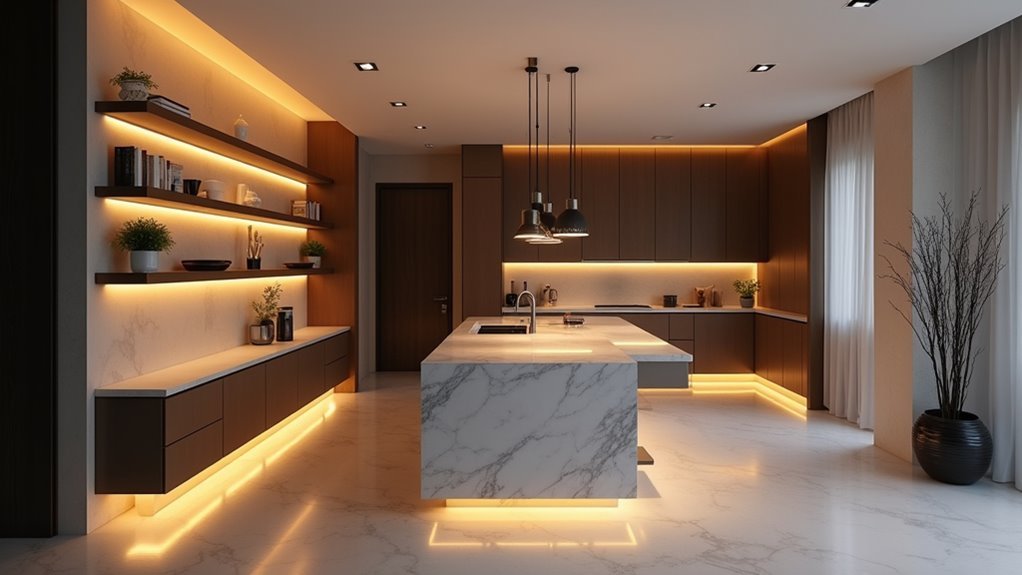
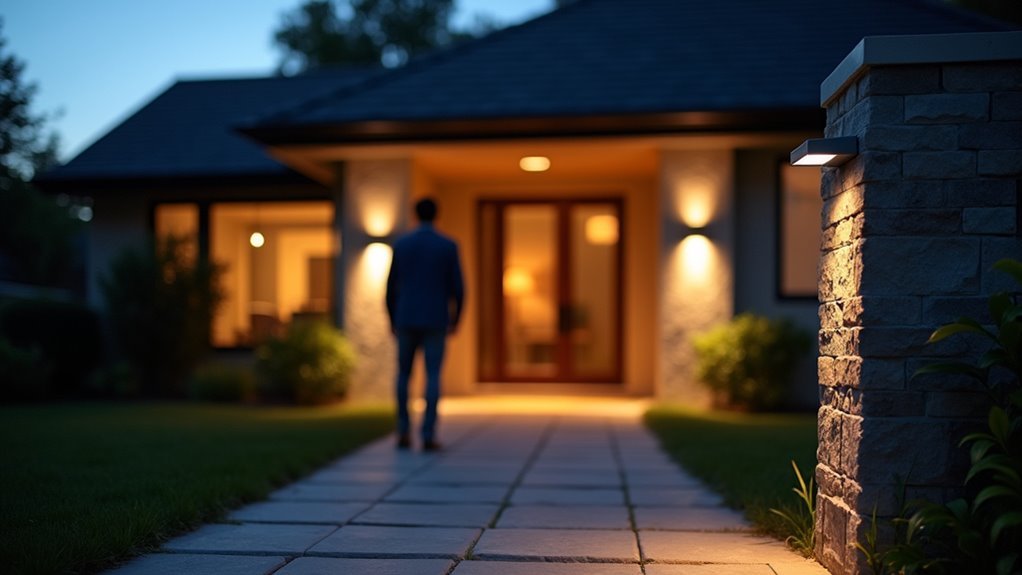
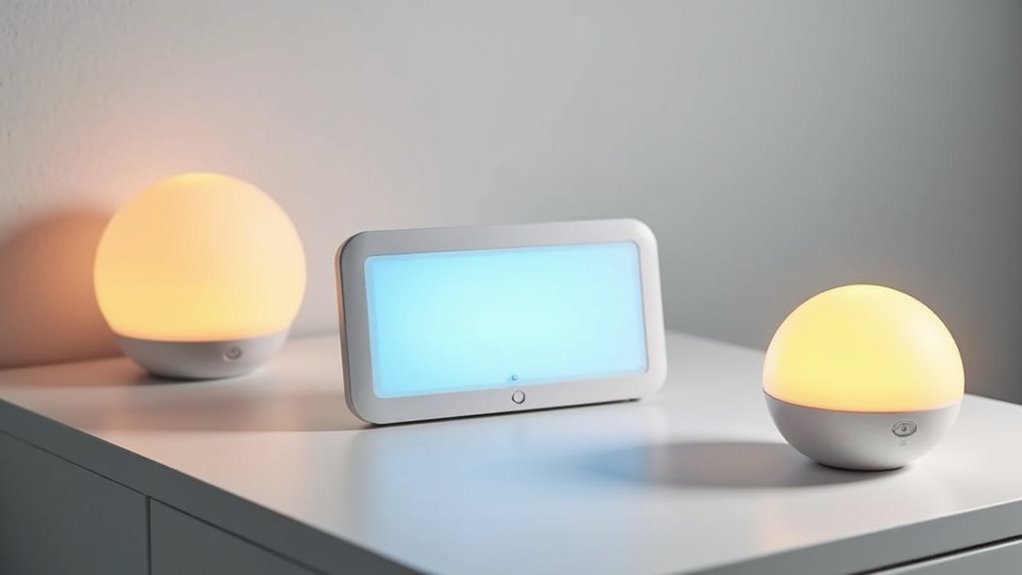
Leave a Reply